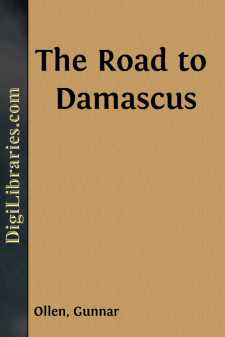Categories
- Antiques & Collectibles 13
- Architecture 36
- Art 48
- Bibles 22
- Biography & Autobiography 813
- Body, Mind & Spirit 142
- Business & Economics 28
- Children's Books 15
- Children's Fiction 12
- Computers 4
- Cooking 94
- Crafts & Hobbies 4
- Drama 346
- Education 46
- Family & Relationships 57
- Fiction 11829
- Games 19
- Gardening 17
- Health & Fitness 34
- History 1377
- House & Home 1
- Humor 147
- Juvenile Fiction 1873
- Juvenile Nonfiction 202
- Language Arts & Disciplines 88
- Law 16
- Literary Collections 686
- Literary Criticism 179
- Mathematics 13
- Medical 41
- Music 40
- Nature 179
- Non-Classifiable 1768
- Performing Arts 7
- Periodicals 1453
- Philosophy 64
- Photography 2
- Poetry 896
- Political Science 203
- Psychology 42
- Reference 154
- Religion 513
- Science 126
- Self-Help 84
- Social Science 81
- Sports & Recreation 34
- Study Aids 3
- Technology & Engineering 59
- Transportation 23
- Travel 463
- True Crime 29
The Road to Damascus
by: Gunnar Ollen
Description:
Excerpt
INTRODUCTION
Strindberg's great trilogy The Road to Damascus presents many mysteries to the uninitiated. Its peculiar changes of mood, its gallery of half unreal characters, its bizarre episodes combine to make it a bewilderingly rich but rather 'difficult' work. It cannot be recommended to the lover of light drama or the seeker of momentary distraction. The Road to Damascus does not deal with the superficial strata of human life, but probes into those depths where the problems of God, and death, and eternity become terrifying realities.
Many authors have, of course, dealt with the profoundest problems of humanity without, on that account, having been able to evoke our interest. There may have been too much philosophy and too little art in the presentation of the subject, too little reality and too much soaring into the heights. That is not so with Strindberg's drama. It is a trenchant settling of accounts between a complex and fascinating individual—the author—and his past, and the realistic scenes have often been transplanted in detail from his own changeful life.
In order fully to understand The Road to Damascus it is therefore essential to know at least the most important features of that background of real life, out of which the drama has grown.
Parts I and II of the trilogy were written in 1898, while Part III was added somewhat later, in the years 1900-1901. In 1898 Strindberg had only half emerged from what was by far the severest of the many crises through which in his troubled life he had to pass. He had overcome the worst period of terror, which had brought him dangerously near the borders of sanity, and he felt as if he could again open his eyes and breathe freely. He was not free from that nervous pressure under which he had been working, but the worst of the inner tension had relaxed and he felt the need of taking a survey of what had happened, of summarising and trying to fathom what could have been underlying his apparently unaccountable experiences. The literary outcome of this settling of accounts with the past was The Road to Damascus.
The Road to Damascus might be termed a marriage drama, a mystery drama, or a drama of penance and conversion, according as preponderance is given to one or other of its characteristics. The question then arises: what was it in the drama which was of deepest significance to the author himself? The answer is to be found in the title, with its allusion to the narrative in the Acts of the Apostles of the journey of Saul, the persecutor, the scoffer, who, on his way to Damascus, had an awe-inspiring vision, which converted Saul, the hater of Christ, into Paul, the apostle of the Gentiles. Strindberg's drama describes the progress of the author right up to his conversion, shows how stage by stage he relinquishes worldly things, scientific renown, and above all woman, and finally, when nothing more binds him to this world, takes the vows of a monk and enters a monastery where no dogmas or theology, but only broadminded humanity and resignation hold sway....


